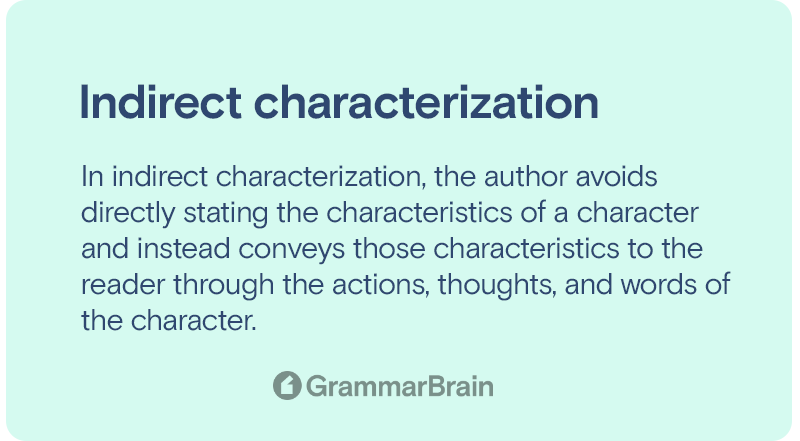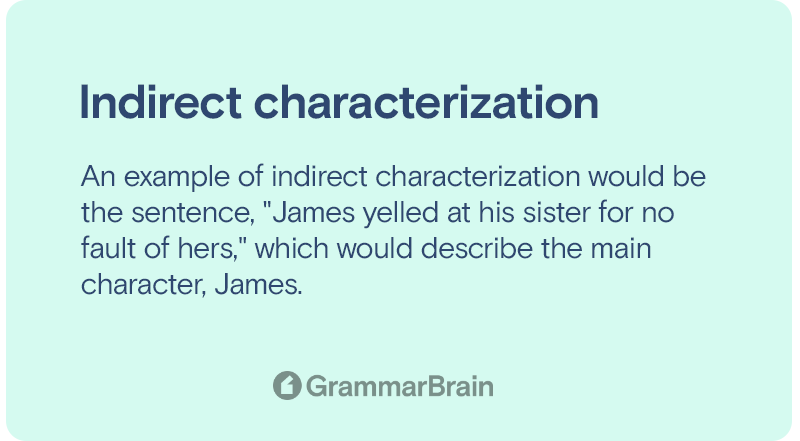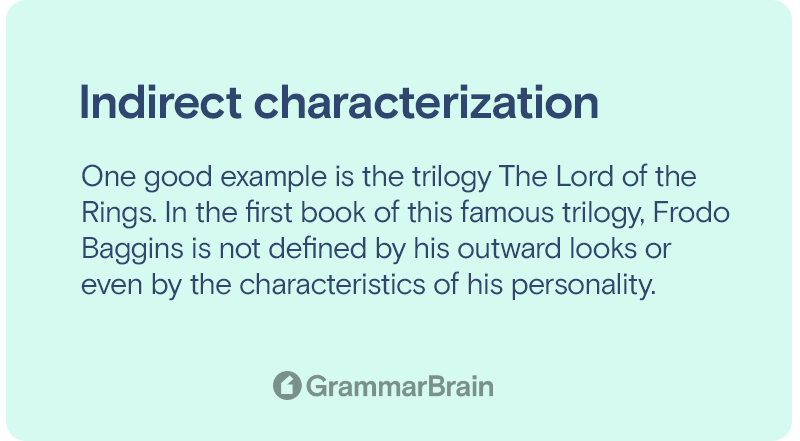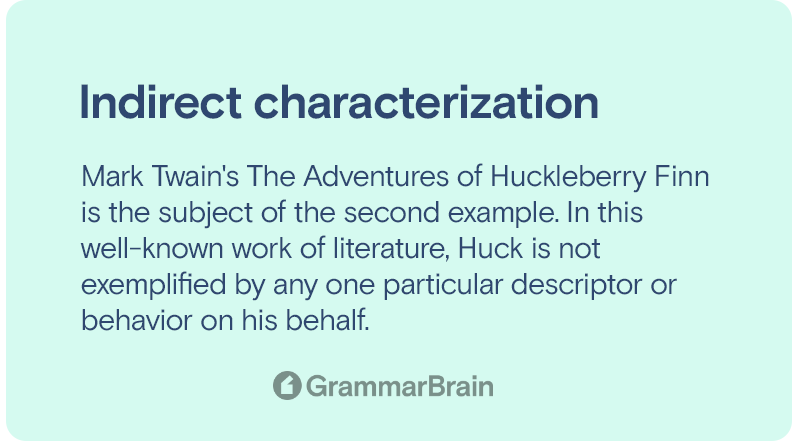What is indirect characterization? How does it work? One sort of literary device is called indirect characterization, and its purpose is to communicate information about a character without directly revealing that information.
The author does not just describe a character. He demonstrates that character’s characteristics by that character’s actions, words, thoughts, appearance, and how other characters react to them. In this article, we’ll define indirect characterization and compare it with direct characterization in literature.

What is indirect characterization?
In indirect characterization, the author avoids directly stating the characteristics of a character and instead conveys those characteristics to the reader through the actions, thoughts, and words of the character.
Example of indirect characterization:
An example of indirect characterization would be the sentence, “James yelled at his sister for no fault of hers,” which would describe the main character, James.
To characterize James in a straightforward manner, one may simply remark, “James had a short fuse.”
Direct characterization is one of the most important strategies utilized in creative writing, yet it is not without its flaws. Let’s have a look at what is meant by the term “indirect characterization.”
When trying to determine the precise definition of indirect characterization, it can be difficult at times. However, in general, it refers to situations in which the reader learns something about a character without being told it directly.
Direct characterization is an alternative to indirect characterization, in which the author expressly conveys information to the reader about the character being portrayed, such as the individual’s occupation, sentiments, or motives.

Why is it vital to characterize people indirectly?
Not only is character development in general essential to the craft of narrative writing, but it’s also a lot of fun!
Increasing expression
The entertainment value of literature is enhanced when characters are presented in a manner that is true to life. Attachments are frequently formed to certain tales as a result of the way in which we are able to identify with particular protagonists or antagonists.
Character development
The process of character development is not something that an author undertakes only once. Instead, characterization is the end result of many various aspects of a character’s behavior at many different points in time.
When all of these elements are combined, a multi-dimensional persona is grounded in realism.
When it comes to developing a character, indirect characterization offers a few benefits that cannot be obtained via the use of direct characterization.
Indirect and direct characterization on characters
To be more specific, indirect characterization calls for a greater level of engagement from the reader with the writing than does direct characterization. Instead of providing your reader with the answers for them, indirect characterization assists them in coming to their own conclusions.
When the reader is required to think for themselves and piece together the puzzle on their own, the novel and the characters in it become more relatable to them.
Direct characterization, on the other hand, is preferable in some circumstances to be more explicit and convey the characteristics of a character in a more forthright manner.
What are the key distinctions between direct and indirect characterization?
The distinction between direct and indirect characterization may be summarized by the way the author states things. So, we look at whether the author states anything explicitly to the reader (direct) or if they imply that something is the case (indirect).
To put it another way, direct characterization consists of telling, and indirect characterization consists of showing.
Take, for instance, the scenario to describe why a certain individual is kind and thoughtful.
To characterize them directly, something like this may be said:
- Hermione was one of the most intelligent students at Hogwarts. This was largely due to the fact that she had spent her whole childhood in the company of books and other sources of information.
Indirect character analysis is more nuanced than direct analysis since it relies on clues and indications rather than directly articulating the information.
- As soon as she saw Ron, Hermione immediately went inside her purse to pull out something. She was determined to make sure that she assisted him with his work since she recalled how embarrassing it might be if the project was not completed on time.
Understanding how to employ both direct and indirect methods of character development is an important aspect of writing, particularly whether one is writing a book or a short story.
When and how should someone employ characterization that is indirect?
To employ indirect characterization in writing styles, here are three helpful recommendations from experts.
1. Pay attention to the smallest of details
Characterization can be conveyed indirectly through the use of minute details that, in real life, would go unnoticed.
For example, the manner in which a character adjusts their hair, the condition of their clothing, or subtle body language are all examples of such details.
Not only do these minuscule particulars disclose a great deal about your character, but they also render your narrative more colorful and true to life.
2. Reveal more about a character by describing their house or the way they live
A fantastic fast cut to revealing a character’s personality is to discuss their living situation and the way they spend their time.
This provides a significant amount of insight into the sort of person that they are. Other aspects, such as what time of day they get up and whether or not they have pets are wonderful ways to infer aspects of their personality.
3. Make use of both consistency and repetition
A character, just like people in real life, will repeatedly exhibit the main features that define who they are. The challenge for a writer is to think of several methods to demonstrate the same concept.
To illustrate that a character is forgetful, for instance, have them come late to an appointment. Another way to do so is to inquire about a person’s name many times and neglect an assignment at work. These are all examples of things that could be done.
Having all three events take place at the same time has a more profound effect than having just one take place on its own. The consistency makes it simpler for the reader to get a solid impression of the character.
Which subcategories fall under the category of indirect characterization?
Any piece of writing that allows us to infer or deduce anything about a person’s mental state, feelings, values, or mannerisms is referred to as psychographic writing. Take, for instance:
1. Inferences drawn from a character’s dialogue: It can tell the reader a lot about that character, including whether or not they are kind, harsh, compassionate, etc. It depends on how the character interacts with other people in the tale.
2. Implying a character’s traits through their actions: What your character does gives clues about their personality.
3. Fly-on-the-wall description: A visual description indicates may vary from nation to country and culture to culture. However, a neutrally phrased description may encourage the readers to make certain conclusions depending on what the author has shown them.
What are some examples of indirect characterization in literature and real life?

Lord of the Rings
One good example is the trilogy The Lord of the Rings. In the first book of this famous trilogy, Frodo Baggins is not defined by his outward looks or even by the characteristics of his personality.
Instead, he is defined by his deeds and the things that he accomplishes for the benefit of others.
The spectator gets a sense of how Frodo feels about doing what is right rather than what is simple or convenient for himself.
This is a result of his continuous willingness to put his own well-being in harm’s way for others around him. Because of this, he is quickly becoming one of my all-time favorite fictional characters.

The Adventures of Huckleberry Finn by Mark Twain
Mark Twain’s The Adventures of Huckleberry Finn is the subject of the second example. In this well-known work of literature, Huck is not exemplified by any one particular descriptor or behavior on his behalf.
Instead, his personality is gleaned through the things that other characters in the story say and do. For instance, when Huck makes the decision to assist Jim in evading slavery.
FAQs
1. What exactly does the term “indirect characterization” mean?
One sort of literary device is called indirect characterization, and its purpose is to communicate information about a character without directly revealing that information.
2. How to tell whether someone is being characterized indirectly?
Words, deeds, and ideas spoken by a character, in addition to the reactions of other characters to that character, are all ways in which a writer might divulge information about a character’s personality.
3. What are the five different ways to characterize someone indirectly?
The following is a list of the five different forms of indirect characterization:
- Outward Aspect
- Activities
- Reflections
- Words
- Various responses
4. What’s the purpose of characterization?
Both direct and indirect help to portray a character’s personality traits. Indirect characterizations shows rather than tells the reader.
Sources
- What Is Indirect Characterization: The Definitive Guide
- What is Indirect Characterization — Character Building Tips
- Direct vs indirect characterization: How to show and tell
- What Is Indirect Characterization in Literature?
Inside this article
Fact checked:
Content is rigorously reviewed by a team of qualified and experienced fact checkers. Fact checkers review articles for factual accuracy, relevance, and timeliness. Learn more.
Core lessons
Glossary
- Abstract Noun
- Accusative Case
- Anecdote
- Antonym
- Active Sentence
- Adverb
- Adjective
- Allegory
- Alliteration
- Adjective Clause
- Adjective Phrase
- Ampersand
- Anastrophe
- Adverbial Clause
- Appositive Phrase
- Clause
- Compound Adjective
- Complex Sentence
- Compound Words
- Compound Predicate
- Common Noun
- Comparative Adjective
- Comparative and Superlative
- Compound Noun
- Compound Subject
- Compound Sentence
- Copular Verb
- Collective Noun
- Colloquialism
- Conciseness
- Consonance
- Conditional
- Concrete Noun
- Conjunction
- Conjugation
- Conditional Sentence
- Comma Splice
- Correlative Conjunction
- Coordinating Conjunction
- Coordinate Adjective
- Cumulative Adjective
- Dative Case
- Determiner
- Declarative Sentence
- Declarative Statement
- Direct Object Pronoun
- Direct Object
- Diction
- Diphthong
- Dangling Modifier
- Demonstrative Pronoun
- Demonstrative Adjective
- Direct Characterization
- Definite Article
- Doublespeak
- False Dilemma Fallacy
- Future Perfect Progressive
- Future Simple
- Future Perfect Continuous
- Future Perfect
- First Conditional
- Irregular Adjective
- Irregular Verb
- Imperative Sentence
- Indefinite Article
- Intransitive Verb
- Introductory Phrase
- Indefinite Pronoun
- Indirect Characterization
- Interrogative Sentence
- Intensive Pronoun
- Inanimate Object
- Indefinite Tense
- Infinitive Phrase
- Interjection
- Intensifier
- Infinitive
- Indicative Mood
- Participle
- Parallelism
- Prepositional Phrase
- Past Simple Tense
- Past Continuous Tense
- Past Perfect Tense
- Past Progressive Tense
- Present Simple Tense
- Present Perfect Tense
- Personal Pronoun
- Personification
- Persuasive Writing
- Parallel Structure
- Phrasal Verb
- Predicate Adjective
- Predicate Nominative
- Phonetic Language
- Plural Noun
- Punctuation
- Punctuation Marks
- Preposition
- Preposition of Place
- Parts of Speech
- Possessive Adjective
- Possessive Determiner
- Possessive Case
- Possessive Noun
- Proper Adjective
- Proper Noun
- Present Participle
- Prefix
- Predicate



